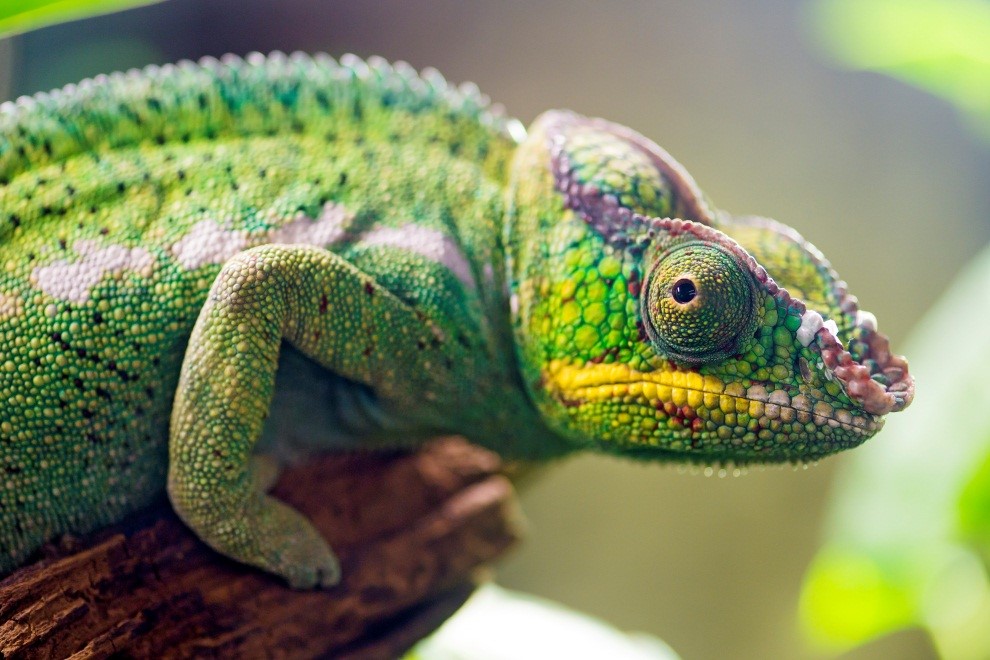CHAPTERS
Navigate to chapter
► Chapter One: All About the Panther Chameleon
► Chapter Two: The Panther Chameleon Care Sheet
► Chapter Three: Choosing and Bringing Home Your First Panther Chameleon
► Chapter Four: Common Illnesses of Panther Chameleons and How to Prevent Them
► Chapter Five: Handling a Panther Chameleon Properly
► Chapter Six: The Panther Chameleon as a Pet
► Chapter Seven: Life Cycle, Reproduction, and Frequently Asked Questions
Chapter One: All About the Panther Chameleon

Chameleons, scientific name Chamaeleonidae, are interesting reptiles. They are a very unique and distinguished lizard species. They have a lifespan of two to eight years, depending on their living conditions, and usually live a solitary lifestyle. Chameleons are distinct because they have large eyes and coiled tails. Their body is covered in scales and they come in many colors: brown, black, green, tan, yellow and red—although they can shift colors, and that is what makes them very fascinating and distinctive.
Chameleons can be seen throughout different deserts, tropical forests and jungles in Asia, Africa, and some locations in North America and Southern Europe. It is believed that there are more than a hundred and eighty diverse species of chameleons. Some are a couple of feet long while others are just a little more than an inch (from 2.8 centimeters to 68.5 centimeters). The smallest and largest chameleon species are native to Madagascar. The smallest chameleon, pygmy leaf, measures less than three centimeters in length. The largest chameleon species, the Malagasy giant, grows to about 70 centimeters long. Another large chameleon species also found in Madagascar is the Parson’s chameleon, which can develop to about 60 centimeters long. Chameleons’ weight ranges from .01 kilograms to 2 kilograms.
A Panther Chameleon (Furcifer pardalis) is called as such because of its spotted markings that make it appear like a panther and its forked feet. The name Furcifer pardalis is from the Latin furci which means “forked” and pardalis which means “spotted like a leopard or panther”. It is one of the more colorful species of chameleons.
Over the last couple of decades, the Panther Chameleon has become more popular because of the stunning and impressive array of colors and its curious behavior. Hobbyists, pet owners, and breeders prefer the Panther Chameleons imported from Madagascar. In the beginning, the Panther Chameleon had the reputation of being a difficult reptile to care for because imported chameleons came with poor conditions and health issues such as infections, dehydration, wounds, parasites, poor immune system and depression. In the early 1980s, importing these exotic animals was difficult and captive propagation programs as well as care protocols were set in place to improve the survival of Panther Chameleons. The efforts to improve husbandry and care were successful and today, there is a growing number of more robust Panther Chameleons in the market.
More and more people choose captive-bred Panther Chameleons compared to wild-caught ones for a variety of reasons: the age of a Panther Chameleon caught from the wild cannot be ascertained and the health or lifespan cannot be determined for sure. However, advanced breeders or hobbyists love to care for and acclimate imported Panther Chameleons.
The brilliant color phases of the Panther Chameleon will tell you, from which part of Madagascar they come from, such as the cities of Nosy Be, Ambanja, Sambava, Ambilobe, Tamtave, etc. Male Panther Chameleons are larger than females, ranging from 15 to 20 inches long. Full-sized, mature female Panther Chameleons grow up to 8 or 10 inches in length.
You can easily tell the gender of Panther Chameleons—the males’ skins are spiky and horny while the females’ skins are usually smoother. Male Panther Chameleons are aggressive and they protect their territories, hence the horns.
Panther Chameleons in the wild, their natural habitat, usually have a short lifespan. They can live for about one or two years, largely because of the perils of disease, parasite infection and predators. Male Panther Chameleons bred in captivity usually live up to 4 or 6 years, or even up to 8 or 9 years in excellent conditions. Captivity decreases a female’s lifespan. Female Panther Chameleons in captivity has a lifespan of 2 to 3 years after laying eggs. Virgin females, because they are free from the burden of reproduction, can live up to 8 years in captivity. When they are well taken care of, Panther Chameleons are robust and healthy and can live their whole life cycle.
The Panther Chameleon’s Excellent Vision
Panther Chameleons, like all species of chameleons, are known to have excellent eyesight. They can see up to 10 meters from where they are. They are capable of moving their eyes in a 360-degrees fashion so they can see all around their body. This specialty allows them to spot their prey as well as catch sight of predators. Panther Chameleons also have the special skill of seeing ultraviolet light. In contrast, the Panther Chameleon’s hearing is rather poor and can only function within a limited range.
What’s so special about a chameleon’s eyes? Other than the fact that they can rotate their eyes in a 360-degree fashion, they are the only animals that have the ability to transition between their monocular and binocular vision. They can see things with each eye independently. The chameleon’s eyes, located on the opposite sides of its head, can rotate with total freedom and provide a view in front, behind and of the sides.
How does this special ability help chameleons survive in the wild? While they are in search of prey, they utilize their monocular vision on each eye. The eye movements on both eyes are uncoupled—there are two separate bundles of eye nerves that function, allowing the Panther Chameleon to have a panoramic view of its surroundings with both eyes providing two separate images to the brain. . When the chameleon catches sight of its prey, both the eyes are coupled and they lock on the object. Once the eye movements are in sync, there is one image only and the head rotates towards it. The chameleon then uses its tongue to catch its prey. The same happens when there is a predator around, and the chameleon responds with a defensive action.
Continue Reading…
Want to read the entire thing?

